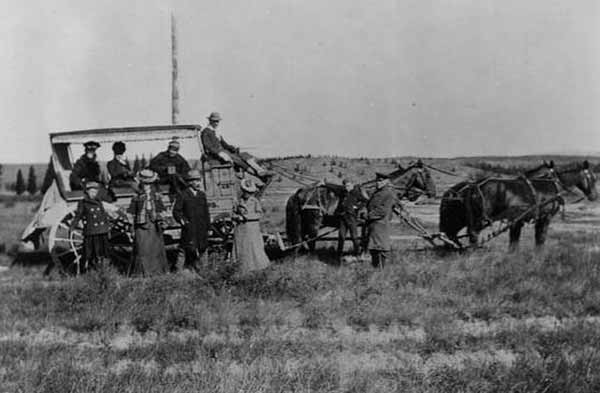
Emma Cowan and her husband return in 1905 to the spot in Yellowstone National Park where they were captured by Nez Perce Indians. (Bozeman Pioneer Museum)
By M. Mark Miller
Emma Cowan and her family visited Yellowstone National Park in 1877 — the year the U.S. Army pursued the Nez Perce Indians there. The Nez Perce generally had amicable relations with whites, but in what has become a familiar story, the peace was shattered when gold was discovered on their land. Some Nez Perce acquiesced to government demands that they move to a tiny reservation, but others decided to flee their homeland instead.
The Army sent soldiers to subdue the defiant Nez Perce, but the Indians defeated them several times. In the most dramatic battle, the Army made a pre-dawn attack on a sleeping Nez Perce camp on the banks the Big Hole River in southwest Montana. The Indians rallied, drove back their attackers, then retreated leaving their equipment, teepees, and at least 89 dead—most of them women and children.
After the battle, they fled though Yellowstone Park where they captured Emma’s party. Here’s her account of what happened later.
Every Indian carried a splendid gun, with belts full of cartridges. As the morning sunshine glinted on the polished surface of the gun barrels, a regiment of soldiers could have not looked more formidable. The Indians pretended all the while to be our very good friends, saying that if they should let us go, bad Indians, as they termed them, would kill us.
Suddenly, without warning, shots rang out. Two Indians came dashing down the trail in front of us. My husband was getting off his horse. I wondered what the reason. I soon knew, for he fell as soon as he reached the ground—fell heading downhill. Shots followed and Indian yells, and all was confusion. In less time than it takes to tell it, I was off my horse and by my husband’s side….
I heard my sister’s screams and called to her. She came and crouched by me, as I knelt by his side. I saw he was wounded in the leg above the knee, and by the way the blood spurted out I feared an artery had been severed. He asked for water. I dared not leave him to get it.
I think we both glanced up the hill at the same moment, for he said, “Keep quiet. It won’t last long.” That thought had flashed through my mind also. Every gun in the whole party of Indians was leveled at us three. I shall never forget the picture, which left an impression that years cannot efface. The holes in those gun barrels looked as big as saucers.
I gave it only a glance, for my attention was drawn to something near at hand. A pressure on my shoulder was drawing me away from my husband. Looking back over my shoulder, I saw an Indian with an immense navy pistol trying to get a shot at my husband’s head. Wrenching my arm from his grasp, I leaned over my husband, only to be roughly drawn aside. Another Indian stepped up, a pistol shot rang out, my husband’s head fell back, and a red stream trickled down his face from beneath his hat. The warm sunshine, the smell of blood, the horror of it all, a faint remembrance of seeing rocks thrown at his head, my sister’s screams, a faint sick feeling, and all was blank.
 Two days later, the Indians released Emma, her sister, Ida, and her brother, Frank. They made their way to Mammoth Hot Springs where they found help. Emma’s husband, George, survived the shooting. He carried the slug that an Army surgeon dug out of his head as a watch fob for the rest of his life.
Two days later, the Indians released Emma, her sister, Ida, and her brother, Frank. They made their way to Mammoth Hot Springs where they found help. Emma’s husband, George, survived the shooting. He carried the slug that an Army surgeon dug out of his head as a watch fob for the rest of his life.
While making their way through the Yellowstone wilderness, the Nez Perce discovered they were not welcome with their old friends, the Crow, who had made accommodations with the whites. The Nez Perce decided to head north to join Sitting Bull and his Sioux in Canada. In October, the starving and exhausted remnants of the band surrendered to the Army just 40 miles from the Canadian border.
Emma’s complete story is included in M. Mark Miller’s Adventures in Yellowstone: Early Travelers Tell Their Tales.
